Introdução
Upgrade your hard drive for more storage space!
This guide also includes steps to upgrade your iMac's hard drive with a SSD. It describes how to install the SSD's temperature sensor so that the Mac's fans will operate at the correct speed.
Before beginning any work on your iMac: Unplug the computer and press and hold the power button for ten seconds to discharge the power supply's capacitors.
Be very careful not to touch the capacitor leads or any exposed solder joints on the back of the power supply.
O que você precisa
-
Ferramenta utilizada neste passo:Heavy-Duty Suction Cups (Pair)$14.95
-
Stick a heavy-duty suction cup near each of the two top corners of the glass panel.
-
While lightly holding the suction cup against the glass, raise the movable handle until it is parallel with the other handle (as indicated by the third picture).
-
-
-
Gently lift the glass panel perpendicular to the face of the LCD, enough to clear the steel mounting pins attached along the underside of the top edge of the glass panel.
-
Pull the glass panel away from the lower edge of the iMac and carefully set it aside.
you should do this mac up, because, for me, one of the suction cup failed, and the glass fall into the lcd screen. Now there is a big hole in it...
do you still have this panel?
Reassembly: After powering on and running for a few minutes, found a large whitish patch on the screen. Persists after powerdown.
Turned out to be condensation, though it didn't look like it - more like fine white powder rubbed in. Humidity is very high this time of the year. Fix: start airconditioner in a room, leave it running a while, take iMac in, prise open the glass again. Condensation vanishes instantly. Keep it out for a ~15 minutes running infinite loops to get iMac nicely heated up and fans running. Snap glass back.
I used a Swiffer dry cloth to get all the dust off the screen while just blowing with my mouth at a steep angle. I know I didn't get every speck, but the screen looks perfect once assembled and lit again. Removing the glass from the screen is pretty easy if you need to re-clean it.
I used a microfiber cloth instead, which worked well. The same type as yo use to clean eye glasses, but in a larger form factor.
Daniel -
The Swiffer idea worked great! I just brush it over the LCD and glass panel lightly, and all dust particles are gone quickly. The screen after boot up looked beautiful. Thanks!
dtsai2 -
I didn't crack the screen, but it popped out of the shims and then popped back in, as if the glass edge is magnetic or has steel in it to connect to magnets. Be careful with this step — it is pretty nerve-wracking, but doable!
You need a big clean surface free, or at least 2 or more free surfaces because the iMac, the glass and the LCD display are quite bulky. You'll also probably need space for a tablet or a laptop to read this guide while you are working. And don't forget room to work on the optical unit and for the tools you are going to use. I covered a large table with a double layer of bubble wrap. In my opinion it's better to put the glass face down to limit powder sticking on the internal surface.
Thanks good advice! I was wondering exactly about the working space issue!
I am doing this repair now. After successfully lifting off the glass panel (yay!), dust blew out of the lower open edge. So I sprayed a can of air around edges. But a poof of the “air” condensated on the LCD. Does anyone know if I can clean the LCD same as how the glass is cleaned (damp cloth with equal parts white distilled vinegar/distilled water) and if not then how?
Hi Amy,
To clean the LCD panel, I would suggest using a clean microfiber cloth and rubbing alcohol. Distilled water can be used, but avoid regular water, which contains minerals. Make sure the microfiber cloth is absolutely clean and has no hard particles sticking on the surface, which will scratch your LCD when you wipe it.
Wet the surface with some alcohol and gently wipe with the microfiber cloth. Wipe in one direction.
I find that the LCD is not as fragile as we all think. they are very much like any LCD on a tv or monitor. There is no extra glass on the front of a monitor. Not the 23 HP Pro Displays I have anyway. I know this because I punctured one moving my video wall. so I took it apart to know how its put together. I will say, there are several 'lens’ like sheets and a reflective (silver} sheets that are the same size as the panel. and a 1/8”piece of acrylic, all behind the LCD panel. Take care with them and clean as you would your monitor.
My suggestion is to stand the iMac up after the panel is secured back into the body of the iMac and clean while its vertical. took me 3 attempts before I realized that while laying flat the surface is large and collects dust with mind blowing speed.
If the LCD glass is badly cracked and broken you need to be extra careful removing as the sharp shard of broken glass can scratch/harm the underlying screen as they may “fall in or onto” the screen below.
I found that strategically putting sheets of 8x11 paper(s) under the sharpest, largest broken sections help protect the underlying screen. A vacuum was also helpful removing some of the small glass shards.
Be advised: I did a perfect replacement of the hard drive, temperature sensor to the SSD, LCD screwed in, glass cleaned. I went to put back the final glass, I set the bottom edge in place and as I slowly moved to have the magnets take hold, they pulled the screen out of my gingerly held fingers, and smacked into place……cracking the glass! Ugh! So, on this last step, hold tight as you put the glass back in slowly. It will cost you about 40-50 bucks for a new glass (mine is on it’s way).
Yikes... that sucks. thanks for sharing this information. I took everyone's advice and removed and placed this back very very carefully.
Don't trust the suction cups after you remove the screen cover. Used both hands to hold this piece carefully!
As far as the last point of step 2 goes, I would add to the parts list a can of compressed air to get rid of all the dust on the screen frame and the interior body once the lcd is off). When the magnets clip back in dust will shower down onto the lcd and glass if you do not clean the frame well. It will not matter how much you clean the LCD and inside of the glass panel.
done, easy, clean,
-
-
-
Remove the eight T10 Torx screws securing the LCD to the outer case.
The replacement display I received did not have a bracket around the edges so I can reinstall it. On the old display, it seems the bracket is screwed in, but even with all screws removed, I cannot get it to budge. Is there a trick? Is this even possible?
Reassembly: be careful with the screws! The magnets attract them and the screwdriver as well! Better to use a screwdriver without replaceable end insert. I had to use one of this second type and I struggled a lot!
https://m.youtube.com/watch?v=nB172HJeM0...
Try this easy GPU fix before buying a new graphics card! It fixed the white screen issue on my EMC 2374.
Mine has T9 screws.
-
-
-
Carefully lay the iMac stand-side down on a flat surface.
-
Use a thin hooked tool to lift one side of the top edge of the display by its steel outer frame.
Be careful with any tool while lifting the edge of the display. Under the top left edge of the display sits the bluetooth-antenna-connector. I pulled it out while lifting. It was not such a great problem, cause i could just plug it in again. But maybe you could cut the small cable depending on the tool you use to lift.
The display is quite heavy, an is fitted with a tight tolerance. I found it very difficult and dangerous, lifting it with any tool in one corner while the iMac was lying down. Instead, after removing the T10 screws, it was quite easy pulling the display out of the iMac with my fingers on both sides, while the iMac was in the upright position. By doing that, you can easily hold the display with one hand and reach for the connecting cables with the other
I broke the short ribbon cable that attaches to the inner top of the display but all the pics show the display completely removed after all cables are disconnected without the short ribbon cable intact. Does this short ribbon cable have a purpose and does it need to be reconnected? If so, how? Or is it just some worthless control put in by Apple to show its been messed with when brought back for repair? Thanks
Simple tool to use here is long nose pliers on the corners. safer, better control.
I just used my suction cup and pulled it out.. Slowly. No need to dig. We have to clean the screen anyway.
-
-
-
Using your fingers, carefully pull the vertical sync cable out of its socket on the LED driver board near the top left corner of your iMac.
This cable is very small and fiddley to remove if you don't have much in the way of finger nails. The cables are very thin and fragile.
It took me a bit of work to remove this cable, it was a hassle actually. What worked for me, without any tools, was to use your index and middle fingers' nails and pull it. That worked better than the index and thumb. Took me like 15 minutes, more than what it should take.
Yes, me too! It stuck terribly hard and I spent most of the time for the repair for this s**** little connector. I thought all the time, I'm gonna break it or tear off these tiny cables... All the other cables were *rather* easy-going. In the end I finally got a new SanDisk Ultra II 480 GB SSD working.
And thanks to the SDD Fan Control app it is sooo silent. Thanks to Exirion!
When the cable comes out, make note of which side has the gold contacts visible. On my cable, you could only see them from the "top" side (aka, as you look down on it). From the "bottom" or back side of the cable, you could NOT see any gold contacts. This will help to orient the cable when reconnecting it.
From this point onwards I found very useful a flashlight to illuminate inside the iMac.
FYI; Cable in 27 EMC 2390 I just worked on looked different. Was simple flat connecter with nothing other than blue coloring on end. Just flat gold connectors on bottom side. These kinds are very tricky to extract and even trickier to reinsert as there is too much flex and not enough slack/room for finger/tool to get back in.
My solution is unconventional but works. I do not remove the cables (!). I work on the floor, lying on my belly. I open slowly and carefully only as far as the cables inside will allow. Use a flashlight so you can really see clearly. Then I prop up the both sides of the display using anything the right size (box, a pair of boots…) It is crucial of course that you have things propped up securely so screen can stay a few inches up without hands! I use a very short #10 Torx so I can remove the old HD. There is barely enough room to work but it is do-able with care (and light!). As I am usually putting in an SSD these days, I simply use electrical tape to secure it. Close slowly. Test
READ ABOVE ^^^. Don’t risk the other cable removals, just remove and replace drive here. Saved me a ton of worry
Perfect Idea. Even better if you use a table, quite traditional but still today useful invention: you don’t have to work lying in the floor. Makes it a lot more comfortable. To keep the screen propped up I used two wooden sticks of about 20 cm length with small feet made out of cork to make the construction more stable. I only removed the vertical Sync-cable, otherwise you cannot lift the screen that high.
The rest was quite easy. Thanxalot.
My cable was also taped to the inside of the case which made the cable VERY tight. Make sure to pull the cable loose from the case before lifting the display much at all.
-
-
-
Squeeze the two display data cable connector arms together to unlock it from its socket on the logic board.
-
Pull the display data cable connector away from its socket on the logic board.
In my iMac the cable was stuck to the structure of the computer with a piece of foam tape. Pulling it very gently, gradually it detached with no damages.
I managed to damage mine also .. but, it was probably already damaged by Apple when they replaced a recall hard drive. I managed to fix it like Wojtek. had to re-solder tabs to the logic board. Would like to find a dead logic board and de-solder the connector for a spare; however, I think all the little pins fall out if you try that … SIGH!
I also broke this socket. I am able to fit it back over all the pins correctly and reattach the thing using electrical tape to hold i down. However, I see no display (nor backlight) when I turn on the computer. It does chime. Not sure if I got contact with the outer tabs (non pints). Should the backlight turn on even if this cable is unplugged since there is a separate back light cable?
I had the exact same thing happen. Were you able to get it working?
meburt02 -
Be VERY CAREFUL when removing this cable and also putting it back.
Attention avant de déconnecter la prise de la carte mère, le câble peut être collé sur la partie métallique de la carte vidéo (le bras en aluminium avec des croisillons). Le mieux (de mon point de vue) est de chauffer avec un sèche-cheveux la colle sous de la nappe pour la faire ramollir, tout en insérant un médiator afin de décoller la nappe petit à petit en descendant vers le fond du mac (du haut vers le bas) puis d’exercer une pression sur les deux bras du connecteur pour le libérer de la prise sur la carte mère.
-
-
-
Rotate the display out of the outer case enough to disconnect the LED backlight power cable from the LED driver board.
Here I used the flat end of a spudger to unlatch the connector top.
-
-
-
Lift the display for enough clearance to disconnect the LCD thermal sensor cable connector from its socket on the logic board.
Hi Leute, Ich habe bei mir mal die Wärmeleitpaste auf dem Prozessor erneuert und auch Ich habe eine SDD verbaut.
Leider ist nach dem Zusammenbau der Fehler aufgetreten, dass beide Lüfter bis zum Anschlag drehen.
Ich gehe sehr stark davon aus, dass alles korrekt angeschlossen ist. Was ist denn hier die Lösung?
Ich habe die Anschlüsse alle gecheckt. Ich habe den iMac ohne Display hier vor mir stehen und egal welchen Pin ich wo rausziehe die Lüfter bleiben auf der Geschwindigkeit.
Ich brauche Hilfe :D
Grüße ! -
-
-
Carefully pull the display toward the top edge of your iMac and lift it out of the outer case.
And if the panel has no frame? How you unattach the frame from the old panel to place it on the new one?
-
-
-
-
Disconnect the thermal sensor, SATA power, and SATA data cables by pulling their connectors away from the sockets on the hard drive.
The thermal sensor cable is just two wires - it4art is suggesting plugging a tiny wire jumper between the two holes in the cable to create a short-circuit. I do not know how this impacts the system. I tend to use “Macs Fan Control” for these types of things.
The thermal sensor cable has just two wires, grey and black. Grey face top and black face bottom of my screen. Or grey is closest to SATA Connector. my new Seagate SSHD connector has 4 pins and different connector so could not connect thermal sensor cable due to size difference. However easily cut piece off cable connector to fit(with mini hacksaw holding with pliers). Instruction says if multiple pins the grey should be close to SATA connector. This did not work for me. google the correct connector cable for your new drive and you will see where the black and grey wires should connect to. Mine are the two pins furthest from SATA connector. Black bottom and grey top again. You don’t need to buy the new/correct cable! This whole procedure has worked a treat and my 2010 mac is now incredible fast. Thanks so much!
I always find that it helps me when I reassemble all this computer electronics if I photograph the connectors as they are when I find them with my cell phone so I can see where and how they were originally installed. My memory is awful but the photos really help. I also put a little bit of blue masking tape at each port and on the part of the plug that is facing up.
Unfortunately the Seagate Barracuda drive has a completely different set of connections for the thermal sensor compared to the old drive, so I’ve just had to leave it disconnected for now.
-
-
-
Carefully peel off the piece of EMI foam attached to the front of the hard drive.
What if the EMI foam has lost its adhesiveness? What happens if it is not reapplied?
I am using the ifixit kit to upgrade to a solid state drive and the drive is now in a full casing. The drive is now facing up towards the LCD. I don’t think it’s needed any longer.
-
-
-
Line up the SSD connectors with the metal enclosure's sockets.
-
Press the drive against the enclosure sockets until the SSD is firmly seated.
-
-
-
Plug the included sensor-enabled SATA power cable into the enclosure's port.
Can anyone point me to purchasable parts for steps 19 +20: The “sensor-enabled SATA power cable” and “temperature sensor board”? It’s essentially the parts found below listed as “SSD Temperature Sensor compatible with iMac Intel 21.5" and 27" Late 2009-Mid 2010”, but I don’t want to spend $230…
iMac Intel 21.5" and 27" (Late 2009-Mid 2010) SSD Upgrade Kit
Check Amazon. $30 as of 11-1-2023.
-
-
-
Peel the white liner off the back of the small temperature sensor board in order to expose the adhesive.
-
Adhere the temperature sensor board to an exposed, metal surface of the SSD, close to the SATA connector.
-
Fold the excess temperature sensor wires so that they are out of the way while you install the enclosure.
Somewhere along the way, someone else replaced the HD with an SSD on my iMac, but they did not bother to install the temp sensor and just left the temp connector cable dangling, which causes the HD fan to spin full speed. Can the sensors be bought separately?
-
-
-
Find the connector on the motherboard labeled HD TMP or HDD TEMP.
-
If the previous temperature cable is still connected to the board here, disconnect and remove it. You will no longer need it.
-
Connect the temperature sensor's two-wire red-black cable to the motherboard plug labeled HD TMP or HDD TEMP.
-
Route the excess wire so it does not interfere with any other components.
-
To reassemble your device, follow these instructions in reverse order.
To reassemble your device, follow these instructions in reverse order.
Cancelar: não concluí este guia.
248 outras pessoas executaram este guia.
68 comentários
Hey I just replaced my i Mac HDD to a WD Green the previous one was really noisy. Thanks this walkthrough really helped me out. My I Macs now super quiet. This worked well for me. Thanks i fix it.
Your WD green is an SSD or another HDD?
Thanks for the guide guys, managed to replace a broken HDD in no time. However, I'd like to mention that standard torx bits could not be used to remove the display, a normal screwdriver with replacable bits is too thick to fit in, and bits are too short, so you will need something thinner (or longer bits).
Is it ok to replace the HDD with a SDD? (I know there is a tutorial for adding an SSD as a second drive, but I (and I'm sure others) don't have a big enough need or feel comfortable with the process involved.
What did you find out regarding this?
I know it’s been years, but I still have the machine alive and kicking, and I actually have an SSD there since a while. So yeah, that is indeed possible.
This is a great guide. If you take your time and don't rush you wont have any problems. I just replaced the HD in my buddy's 27" iMac and had a blast doing it! Step by Step this guide walks you through the process without any questions. Thanks iFixit!
This guide was really helpful. I now have a super fast 1TB SSD in place of the original hard disk. It's like having a new computer.
I did it! new to this kind but just want a challenge and didn't want to drag my 27" imac into the mall which more than 1 hr away. Everything seems running smoothly except for the fan is on all the time. It's only off when I sleep or shutoff the computer.
Although I read the step carefully over & over again. I noted this issue down because look like it's common mistake. Therefore, I believe after 2nd time re-look and redo, especially on step 8 & 10, I don't know what else can I do to make the fan back to normal again. Any advice please help! thanks
What brand HD did you pull out and what brand HD did you put in?
Use ssdfanctrl app
I just successfully replace the original 1TB Seagate drive with a 480GB OWC SSD drive. It's nice and speedy now, but there was no place to plug in the HD thermal sensor on the SSD, so I just left it off for now. The fans are running full speed, so clearly I need to do something with the cable. Any thoughts?
Success! Everything went fine but I have to agree with Mark's comment from 12/1/2014 in that you can save a lot of time and misery by removing the vertical sync cable in step 5 and then jumping to step 10. I realized this when I found myself reaching back into the cavity, over and past the HD, to unplug the display data cable that was harder to reach than the HD itself. I found the perfect prop to hold the monitor up that gives max height without strain on cables is the box that the suction cups are packed in. Remove the 3 plugs on the HD and hold-down 2 screws and it's out.
Excellent guide. Replaced my failing seagate 1tb with a 2tb from ifixit as I didn't want to do the external sensor approach. All was easy and effective. Some of the connectors were scary only in fear of tearing wires rather than applying removal pressure to just the connectors. First time restoring from TimeMachine too.
I ordered this model of iMac with the stock 256GB SSD as well as a 1TB HDD. I've replaced the HDD easily (thanks to this guide!) but try as I might I can't seem to find any guides anywhere as to how to get to the original SSD and whether that can be replaced by a standard Samsung 850 or whether there are thermal connectors as well...
Does anyone know?
Thanks! :D
No complaints, easy enough. I recommend using small cardboard boxes to hold the screen up at a 30° angle so you can work with both hands
Note, newer technology cells and iMac solid-state adapter bracket, you could easily put a 500 GB or terabyte solid-state in your iMac for zoom zoom time
Diese Anleitung ist hervorragend !!!
Ich habe bereits meinen Mac vor 2 Jahren auf SSD umgerüstet und mittlerweile mehrere andere Geräte von Freunden und Bekannten, die den Mut hatten. ;o)
Hält man sich strikt an diese Anleitung und benutzt einen HDD-Adapter für die SSD, ist es ein Kinderspiel!!!!
I just installed a Seagate ST3000DM001, and I have the fast fan issue, so I took it all part again, and checked for another connector for the drive, and there are none not being used. I put everything back together, and did an SMC reset, and it's still running fast.
1) What could be missing? The existing drive was a Seagate ST31000528AS, and had no extra temperature sensors on it, and no other wiring.
2) Is it the drive? Is it incompatible in some way?
While having it open again, I checked for any other connections that might have been removed, or loosened, and found none. I guess it's not hurting anything running fast, but it would be nice to figure out what's causing it. Thanks!
Install Macs Fan Control
Great guide!! I just upgraded my mid-2010 27" imac to 20gb of RAM and an SSD. I then tried to plug the old 1tb HD (Seagate) to an external usb case for 3.5" HDs, but the drive does not spin up at all.... The case is definitely functional since it operates now with another HD connected to it...I have not tried a second case, since i do not have any... any ideas why the HD is failing?
Did you plug it on the keyboard or straight from the computer ?
Hi, i plugged it directly to the imac... i think the case can not power up the drive... Tomorrow a friend of . mine will drop off his case to try with that ...
case solved!! it was the case... changing the case fixed the problem!!
Great guide. I replaced my failed Seagate 1Tb (factory installed as second drive) with a new Seagate FireCuda 2Tb. By choosing another Seagate I was able to simply plug the existing heat sensor cable on to the new drive and everything works perfectly. No fan issues, no extra software required. Time Machine has restored about 750Gb overnight, and everything is back to normal
I had previously added a 256Gb SSD to the OEM WD1001FALS. Heat issues started recently so swapped in a WD2003FZEX 2tb for the OEM 1tb WD. Because cracking the system is the hardest part, I also swapped out power supplies with one from iFixIt.
On reboot everything else is fine but it doesn't see the WD2003FZEX drive. Tried the cmd-r, the cmd-opt-p-r, and other resetting options with no luck. Cracked open the system again and confirmed the HHD cables are all in right. Still nothing.
Internal SSD boot drive: Fine.
External connectivity and everything else: Fine.
I had pre-formatted the HHD using an external USB cradle and copied my data over in advance of the swap (the OEM HHD was being used for data and large apps not for boot). So I know it was working.
I also used disk utility to see if I might be able to reformat the new drive now that it's internal. DU didn't see it either.
onethumb -
Problem solved! Swapped out the new WD 2Tb HDD and put in a new Samsung 850 Evo SSD. Once buttoned up, the drive was seen and MacOS initialized it without a problem. Data is now being moved from the new WD 2Tb HDD that I put into a USB cradle. It as an external drive but the EMC2390 doesn't like it internally because it's SATA III with 6Gb throughput.
Be advised. The guide above says that as long as you stick with the same manufacture, it will work. 7 years later, that is no longer always true. Make sure the SATA versions match up too.
onethumb -
If I replace the HD, my seagate failed, how do I install the OS?
Did you format the drive before installing? I like to use an internal hard drive enclosure prior to installing that way I can format it.
when changing to an SSD: you just need to leave the thermal sensor cable unattached! then the fans will go crazy at first - then install ssdfanctrl app
(as mentioned by echevarriam79) and that's it! worked like a charm! the ssdfanctrl app is really helpful - it worked flawless on sierra 10.12.4
you could also jump the thermal sensor connector with a piece of wire (https://yktoo.com/en/blog/post/231)
Eric Hew -
I did the jump on the connector for the thermal sensor, as proposed on the blog entry by Eric. Put in a Sandisk SSD and even get a temperature reading for the SSD (which gives plausible and changing values). No fans running - thanks for the hints!
And btw, if you clone your old drive (e.g. with CCC) before onto the new one. Then do the swap - as a result, you just start up the computer with no issues at all.
Alex -
Thanks for simple to use instructions, I'm going to install a 3.5" SSHD into my 2010 27" iMac. Do I need any extra SATA cables or anything besides the tools and hard drive?
Hello! I just installed a Seagate 1TB Firecuda SSHD in my 2010 iMac. All was going well, but when I went to boot it up by pressing Control R,or Option, I kept getting the grey folder ? Icon.
Responses on here say the hardsrive needs to be formatted but like I said, even after holding these keys nothing works. I also made a bootable external drive and tried to run off of that.... was essentially installing an operating system from the external to the Firecuda. But it did not recognize it....
Great guide. I replaced my failed Seagate 1Tb (factory installed) with a new Seagate 1Tb. In the past I added an SSD replacing the optical drive. By choosing another Seagate I was able to simply plug the existing heat sensor cable on to the new drive and everything works perfectly. No fan issues. You can save a lot of time by removing the vertical sync cable in step 5 and then jumping to step 10 (see Mark's comment from 12/1/2014)
I though I had done my research before buying the replacement hard drive. My iMac is EMC:2390 and I bought the Seagate Barracuda ST 1000DM010. The heat sensor connector is too big to fit onto the new drive. It is a square 6 pin connector and the pins on the new drive are only 4 flat so I cant plug the temp connector in. Does anyone know why I have this problem? I have rechecked the parts required for my replacement on this site and it states for the EMC 2390 I can use the Seagate ST 1000DM010.
I’m having that exact same problem. Any luck? Did you use the two other plugs without thermal plug to see if it will work?
I have the same problem. Is there a solution?
Bill
What is the arrangement of the temperature probe connector? is it a 2x3 pin?
Without the temperature sensor, some of the fans will run at full power continuously. As an alternate software solution, you can use Macs Fan Control to override the fan speeds.
The right question is how to fix it rather than why, don’t you think ? Try Macs Fan Control, it should be OK.
Great guide, thanks. I also skipped the steps 6..9. The display could be lifted so far that I was able to insert a DVD case to keep it up.
I then replaced my WD hdd with a SEAGATE SSHD ST1000DX002 and shortend the temp sensor cable. As I thought it will reflect in the system as 0°C.
After 8h of restore from a USB2-external HDD the software SSD-Fancontrol showed me a temp reading of 47°C. Also after some hours of hibernation (sleep mode) the temp showed 22°C (room temp). So it seams to work.
How is that possible without the temp sensor cable connected to the disk?
I had a dead drive and followed this guide and ordered the same brand HDD as the original. The issue I am running into now is that when I access internet recovery mode, the new onboard HDD is not recognized in Disk Utility. Is there any advice on where to go from here. I opened the iMac back up, and reseated all the connections, bu still no disk.
See my comment below - I wonder if you have the same issue I did? The version of Disk Utility that’s bundled with OS X 10.13 was unable to see my new drive - although an earlier version was able to.
Mike D. -
Are you sure the new HDD is OK ?
Very helpful guide - I ran into a maddening snafu with my new drive which I’ll describe in case anyone else has the same problem. In short, after installing the new drive (2 TB Seagate Barracuda, the recommended Seagate replacement drive from iFixit), Disk Utility running on a OS X 10.13 installer USB drive could not see the device (with “show all devices selected”). I was afraid that this was the SATA III issue mentioned in an earlier comment, but after a brief existential crisis, I tried booting from an OS X 10.10 USB installer instead (with the older, better version of Disk Utility). This old version of Disk Utility saw the new device, and after formatting the drive, I booted again from my 10.13 installer, and this time Disk Utility could see the device, allowing me to proceed with my installation of OS X 10.13. Everything seems to be working great, now.
For the 2 TB SSD Hybrid 3.5" Hard Drive, can I use the newer model Seagate Firecuda ST2000DX002 (http://a.co/fpzD8Ik) instead of ST2000DX001?
I did. works great
Hello, I recently purchased the 1tb ssd upgrade for this iMac. I’m in the process of installing the new drive but come to a bump in the road. The old drive has a 6 pin thermal connector, the new ssd only has a flat 4 pin connector. What should I do?
Doing this with a Seagate 2TB SSHD + https://partedmagic.com/ + a USB3.0 drive dock for the old drive. Other than a scare with the LCD temp sensor (the plastic front snapped off, but the pins were still good), this appears to have worked out!
note at end of this procedure you need to restart mac with network connected, holding down Command R to boot from internet. Then select Disk Utility to Erase/format disk. Following that reboot again using Command R and select Time machine to recover from. Works so seamlessly.
Many thanks for the detailed instructions on how to replace the shipped 3.5 inch hard drive with a 2.5 inch SSD. Managed to get this done in under an hour. The cradle I ordered was slightly different to the one used in the guide, which meant I had to modify it a little in order for it to fit.
Bonsoir Sabrina,
Je ne peux que vous conseiller de prendre le kit et ainsi que les outils proposés par iFixit pour votre iMac
https://fr.ifixit.com/Boutique/Mac/iMac-...
Pour la capacité de cueilli-ci je vous laisse choisir, le kit comprend l’ensemble des outils et des pièces nécessaires et visible dans le tutoriel et de plus cela fait vivre le site iFixit.
En espérant avoir répondu à votre question ! Bonne réparation ou upgrade !
Hi, wo bekomme ich das Mac OS El Capitan her um es, wie angezeigt, auf einen USB Stick zum Starten zu laden. Christian
Hi, du kannst dir diese USB Sticks auf ebay bestellen, kosten zwischen 10€ und 30€, einfach im Suchfeld das gewünschte system eingeben und einen Deutschen Händler auswählen, wegen Garantie und Sicherheit, habe mein High Sierra daher, läuft super!
I replaced my failed hard drive with an SSD yesterday by following this guide. It took 90 minutes. If I was to do it again I guess it would take under an hour. The instructions and photos in the guide are excellent.
am I supposed to program the new inserted ssd and if so, how can I do it?
You should use Disk Utility to format it.
My iMac (Intel 27” Middle 2010) already has a HDD (1TB) and SSD (250GB) in it when I bought it.
However I would like to replace the SSD with a bigger one (2TB).
So I guess for this upgrade I don’t need the other parts (e.g. temperature sensor etc.) any more besides the new SSD.
If anyone has some suggestions I will be much appreciated!
Completed this upgrade and did it live on youtube... Thanks Walter! Everything worked out great! no more hard knocking from the HDD. Here is the link; https://www.youtube.com/watch?v=8e9XO-6f...
I dont understand the part which says that you need to retire the "old cable for the thermal sensor", Do you have to replace the thermal sensor?








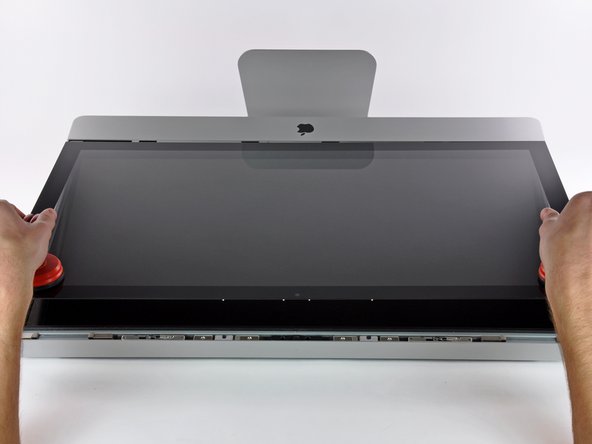















































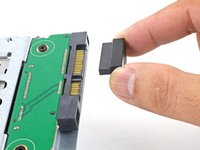
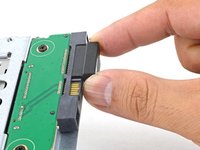



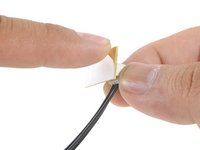
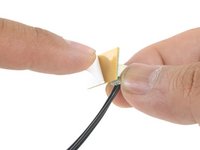
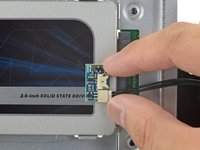


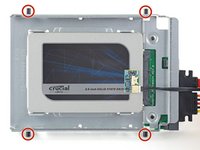
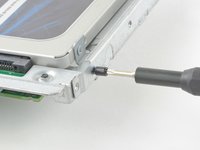


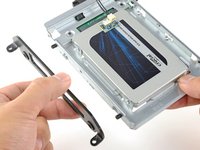
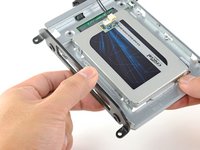


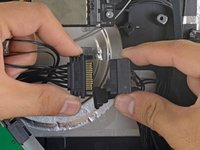
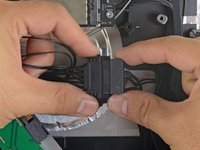


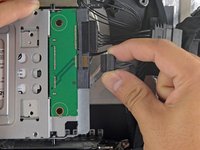
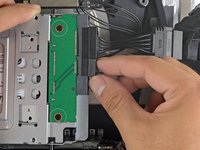
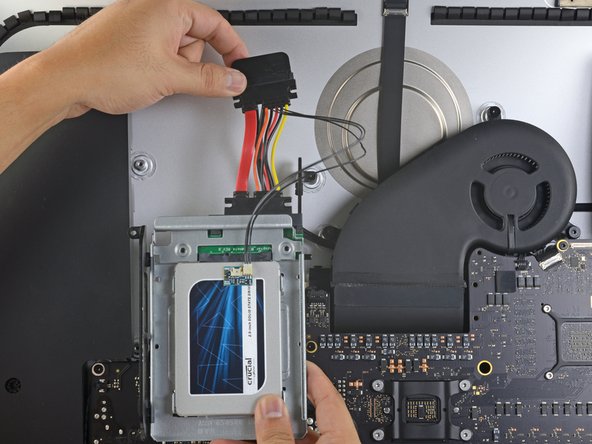


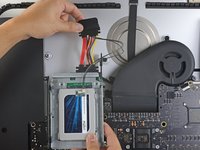
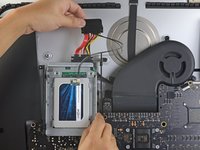
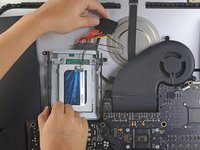



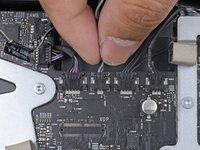
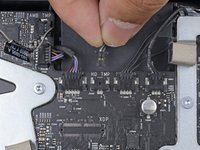
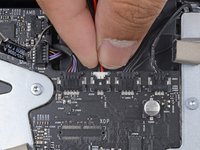

You can easily lift the glass panel off the magnets with only your fingernails (or something thin like a credit card or a guitar pick). No need to buy suction cups you will only use once.
Nick Caron - Responder
Yes, you don't need the specific suction cups to remove the display cover - it's held on by magnets, and if you start at the center by the iSight you can work out to the edges and remove it. I had an iPhone screen suction cup around and it helped with balancing the screen when you pull it out fully, but by no ways is it required.
jtowner - Responder
Great guide and pretty straight forward the only thing that took me ages and I didn't manage to undo were the power btn cable (step 28) and the thermal sensor (step 25) Seemed like they were glued on! Very difficult to remove and obviously conscious so I didn't break anything!
Eddie - Responder
Thanks!!! Worked excellently.
I used a plunger (clean first ;-) to get the screen off, and http://exirion.net/ssdfanctrl/ for fan control.
Then, i did not take out the whole display and left it in the hinges on the bottom side and held it up with two small cardboard boxes. Easy enough to disconnect the hdd then.
I replaced with an ssd, put that into a ssd enclosure. Had to drill an extra hole in it to fasten the pins that hold it in place.
Used Carbon Copy Cloner to make an image from the old hdd, with the sad connected via usb. Checked it of it booted via System Preferences > Startup Disk. It worked so the took the imac apart and replaced the disk. Booted, everything was working as always, only faster!
Frank303 - Responder
I'm replacing my optical drive too. what exactly needs to be plugged into the SSD? I don't have the kit - as I am not sure one is required if I buy something like this: http://www.amazon.com/gp/product/B0056OB...
Can you please advise? Can I do it with this piece, or do I need to get the entire bracket kit?
Allen Borza -
My display data cable forks, with a smaller section going up near the camera board. Where it forks, it is attached to the aluminum plate that attaches around the cpu board. I haven't seen any images that look similar, and I'm stumped at how to remove this second section of the cable. 2010 i7 build to order
Awolf - Responder
Agree with the other comments here. Despite buying suction cups, not sure they were necessary as the screen removed very easily. A sat nav suction cup would do the job fine.
Stuart Bloomfield - Responder
I can confirm that it is possible to remove the front glass using fingernails rather than suction cups. It isn’t easy, but if you try you should be able to pry off the glass.
I did this twice: once at the beginning of the procedure and once again at the end, when I realized that a big pice of lint was trapped under the glass.
gordonhamachi - Responder
Don’t use suction cups. totally unnecessary. screen pops off with fingernails.
Kieran Hobbs - Responder
The reason for caution about suction cups tends to be making sure you don’t apply uneven pressure on the edges of the glass and crack it in the process of removal. I do agree however that some pretty small suction cups would do fine. These suction cups can be had at your local princess auto (Harbor freight) for a few bucks and are useful elsewhere as well. if you use your fingernails or other items just try and do it evenly :)
Abirinder Brar - Responder
good duct tape or gaffer tape wrapped around your hands makes an excellent glass removal 'tool'. Even clear packing tape works a charm.
Stu Blair - Responder
A great first step that minimizes that first gust of dust migration when the glass is lifted is to clean the glass, sides *and the back* before lifting the glass, and then lift SLOWLY. Most of that dust is already trapped inside and pulled up as the screen lifts, but with care you can keep it there (or gently vacuum out with a micro vac…).
John - Responder
before starting any of this…there is a device that you can use that comes with the IFixit kit to format and either clone or restore your hard drive to the new drive…it will save you a lot of headaches..it is a SSD enclosure that you can plug into your existing computer …
Tomr - Responder
Thanks for the instructions. Before doing this the first time, suggest to everyone, read through at least twice. This is the easiest step, as you’ll soon see. As for removing the glass, USE suction cups, either the ones the sell here, or others. DON’T skimp. Also wear gloves when handling the glass. Don’t take chances.
ECJohansen - Responder
Duct tape works too!
Dani - Responder